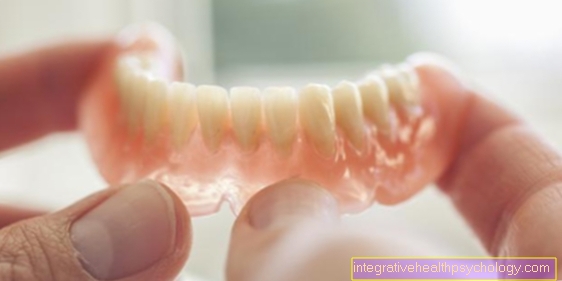mumps
Synonyms in the broadest sense
Goat Peter, parotitis epidemica
definition
Mumps is caused by the mumps virus, which belongs to the group of paramyxoviruses.
The acute, highly contagious (= contagious) viral disease is transmitted by the sick person through droplet infection through direct contact or contact through objects contaminated with saliva.
The main symptom of the patients is a painful inflammation of the salivary glands, which is bilateral in 75% of the cases.

Epidemiology / Occurrence
The mumps virus is spread all over the world and leads to the outbreak of the disease, especially in children during the cold season. After the age of 15, 90% of the population are immune to the mumps virus (they were infected); this immunity lasts for life.
1/3 of those affected show no symptoms of the disease (= so-called clinically inapparent course).
Symptoms
After the virus has incubated in the body for an average of 12 to 25 days, a prodromal stage (= precursor stage) follows, in which the patient has a high temperature, feels dull and weak and may complain of headache, sore throat and earache .
As the disease progresses, patients usually have a high fever and a pronounced general feeling of illness. You suffer primarily from a painful inflammation of the salivary glands, which mainly affects the parotid gland (= parotid, parotid gland):
Initially, the inflammation affects only one side and appears as an indistinct, pasty swelling of the gland in front of and behind the ear.
The earlobe is sticking out due to the swelling and those affected complain of pain in this area, which occurs particularly when chewing.
After about 1-2 days, the other side is also affected by the inflammatory process in 75% of cases.
In principle, the virus can attack all glandular organs in the body, which is why the salivary glands below the tongue and the glands on the lower jaw are also often infected.
In addition, a so-called virus eruption can occur, which is a reddish skin rash, especially on the face.
You might also be interested in this topic: Symptoms of inflammation of the parotid gland
Cause / origin
The virus enters the body through the nasopharynx and multiplies in the respiratory tract and the salivary glands of the head.
The mumps virus then migrates to the lymph nodes, from where, after replicating again, it reaches various organs via the bloodstream and infects them. Virus infestation and inflammatory processes of the salivary glands of the head, especially the parotid gland, are typical, the involvement of the pancreas, meninges, mammary glands as well as the testes and ovaries (= ovaries) are complications of mumps disease.
Route of transmission of mumps
The transmission of mumps occurs via a droplet infection, i.e. by coughing or sneezing. The risk of infection (contagiousness) of the saliva is very high, so that a transmission through objects, e.g. put in the mouth by young children is possible. There is a risk of infection or transmission a maximum of 7 days before to a maximum of 9 days after the onset of the illness.
Read more on the topic: Droplet infection
Mumps pathogen
The causative agent of mumps is a mumps virus from the Paramyxoviridae family that is only found in humans. The virus enters the body through the nasopharynx. The virus then multiplies in the mucous membranes and / or lymph nodes. Eventually the virus passes into the blood and mainly infects the salivary glands. The pathogen can be detected indirectly in the blood via IgM antibodies, which indicate an acute infection, and IgG antibodies, which stand for an illness that has already been overcome or for vaccination.
If the virus colonizes the meninges and causes meningitis (meningitis), antibodies in the brain water (Liquor) being found.
Read more on the topic: Meningitis
Direct detection of the mumps virus is possible using a specific method, the polymerase chain reaction (PCR). The mumps virus can be identified from various body secretions. The pathogen detection must be reported by the responsible laboratory in accordance with Section 7 IfSG (Infection Protection Act).
First signs of mumps
The classic first sign of mumps are the so-called "hamster cheeks". These are caused by inflammation of the parotid glands (parotid glands), which are most commonly affected. The swelling usually begins on one side and then spreads to the opposite side. Reddening of the ducts of the salivary glands on the inside of the cheeks is often another early symptom of mumps. In addition to the swelling and possibly protruding ears, pain also occurs in this area, especially when chewing.
In addition to the parotid glands, all other salivary glands in the body, including the pancreas, can also be affected. In addition to fever and flu-like symptoms, the first signs that come into question are a general reduction in wellbeing.
incubation period
The time between infection and the appearance of the first symptoms (incubation period) is with mumps between 12 and 25 days. Almost half of those infected even show no symptoms at all and only signs of a flu-like infection. Mumps is contagious as early as one week before the first symptoms appear and up to nine days after the salivary glands have decongested. It is important to know that mumps is contagious even without symptoms.
diagnosis
The diagnosis can usually be made by the presence of a typical clinical picture (clinical finding):
The mumps characteristic symptom of parotid gland swelling is decisive for the diagnosis of this infectious disease.
Other diagnostic measures include the determination of antibodies against the mumps virus in the blood:
Antibodies of the IgM class indicate a disease of mumps, while those of the IgG class prove the patient's immunity to the virus. A direct virus detection with the help of a throat swab or from the saliva is only rarely carried out (see immune system).
The amylase level in the blood is characteristically increased; this enzyme is found in saliva and secretions from the pancreas. Since this value is also increased with inflammation of the pancreas, the concentration of the enzymes (= biocatalysts of the body) elastase 1 and lipase in the blood is determined with further laboratory tests. If the values of these two enzymes, which are specific for the pancreas, are in the normal range and an ultrasound examination of the pancreas is normal, an inflammatory involvement of the pancreas is excluded.
Differential diagnosis / exclusion diseases
Salivary stones are to be distinguished from mumps, which prevent the outflow of saliva from the salivary glands of the head and thus lead to an inflammatory process with organ swelling in the duct system of the glands.
The symptoms of lymphadenitis colli are similar to those of the mumps disease: Here there is swelling of the cervical lymph nodes, but this swelling is not painful as in the goat peter and does not cause the earlobes to stick out.
For comprehensive information on various teething problems, please also read our main page: Teething troubles.
therapy
There is no causal therapy for the infectious disease.
Therapy is symptomatic, i.e. its aim is to alleviate symptoms. This can be done with the help of warm bandages of the parotid gland, the food should be given in porridge form to prevent chewing pain as much as possible. Antipyretic and analgesic drugs can also be administered (e.g. ibuprofen, paracetamol).
Duration of the mumps illness
The mumps disease with an inflammatory swelling of the parotid gland can about three to eight days on average stop. Gradients that last longer are also possible. Likewise, the occurrence of complications increases the duration of the mumps illness.
Mumps in adults - what are the differences from children?
Mumps is a typical childhood disease that mainly affects children between the ages of four and 15. However, mumps in adults who are not vaccinated is also possible. Adults who work in health professions or in training centers for children and young people are particularly at risk. One difference between mumps in childhood and adulthood is the higher rate of complications with increasing age.
These complications, from which adults are more frequently affected, include e.g. inflammation of the brain (encephalitis) or meningitis (meningitis), and numbness. Some of the complications can even be fatal, which is why a mumps infection should not be underestimated in adulthood.
Mumps in pregnancy
It has long been believed that a mumps infection can lead to embryo death in the first trimester of pregnancy. However, this assumption has not yet been confirmed. An infection later in pregnancy is also not associated with an increased rate of malformations or miscarriages. A pregnant woman's mumps disease is therefore not as complicated as a rubella or measles infection during pregnancy. However, since the vaccination against mumps can take place together with measles and rubella as a combination vaccine, the vaccination status should be checked and possibly supplemented before each planned pregnancy. This way, the unborn child is not exposed to any unnecessary risks.
Complications
If the testicles in boys or the ovaries (= ovaries) in girls are affected by the generalized inflammatory process, the painful inflammation can lead to infertility.
In girls, inflammatory involvement of the mammary gland and ovaries occurs in 15% of cases.
Inflammation of the meninges (= meningitis) occurs in approx. 5-10% of cases and has a good prognosis, i.e. the likelihood that the inflammation will heal without consequences is high.
Pancreatitis, the inflammation of the pancreas, is another possible complication of mumps. It has a 5% probability of occurrence. It is associated with nausea, vomiting and a greatly increased concentration of amylase (pancreatic enzyme) in the blood.
Read more on the topic: Inflammation of the pancreas
In one in 10,000 cases, the mumps disease leads to inner ear hearing loss, which is why a hearing test should be carried out after an inflammation of the parotid gland.
Rare complications in the form of inflammatory processes affect other organs such as the thyroid gland (= thyroiditis), the heart muscle (= myocarditis) or the kidneys (= nephritis).
Inflammation of the testicles / mumps orchitis
Inflammation of the testicles (orchitis / mumps orchitis) can occur as part of a mumps disease. This usually occurs four to eight days after the parotid glands swell and can last for up to two weeks. There is a severe swelling of the testicle, usually only on one side. In addition, there is tenderness on the swollen testicle. This mainly affects boys during puberty, with an incidence of almost 30% among those over 15 years of age.
Read more on the topic: Testicular mumps and inflammation of the testicles.
Rotation of the testicle (testicular torsion) or an appendage of the testicles (hydatid torsion), as well as epididymitis (epididymitis) are important differential diagnoses of testicular inflammation. Testicular torsion in particular should be ruled out early and, if necessary, operated on, as otherwise there is a risk of infertility.
Read more on the topic: Testicular torsion
The inflammation of the testicles in mumps can lead to a loss of tissue (atrophy) of the testicles, changes in the sperm and, in rare cases, infertility. With bilateral mumps orchitis, however, the risk of infertility is significantly higher. In women, inflammation of the ovaries can occur as a counterpart.
Read more about this in our main article: What are the causes of testicular inflammation?
Note: infertility
In 20% of boys, as a result of mumps, testes are involved if they develop the viral infection after puberty. There is a risk of testicular tissue perishing, which can lead to the above-mentioned infertility.
prophylaxis
There is an effective vaccination against the mumps virus, which is available as a single or combination vaccine (measles, mumps, rubella or measles, mumps).
Read more about this: Vaccination against rubella
The vaccine is a live vaccine: When it is produced, the effects of mumps viruses are weakened and their ability to reproduce is switched off. When the body comes into contact with the weakened form of the virus, the immune system responds, making the child immune to the virus, i.e. contact with the virus does not lead to disease.
The first vaccination should be given to children aged 12 to 15 months and a second vaccination should follow as early as possible, but at least 4 weeks apart.
To prevent the disease and the complications of mumps, all children should receive the mumps vaccination as prophylaxis.
Read more on the topic: MMR vaccination
Vaccination against mumps
According to the vaccination calendar, the StIKo permanent vaccination commission recommends vaccination against mumps for all children. The basic immunization against mumps requires two vaccinations. The first vaccination should be given to children aged 11-14 months. The vaccine is injected into the muscle (intramuscularly). However, vaccination at an earlier point in time should be avoided, as the child's immune response is weakened due to the maternal nest protection that still exists.
The second vaccination follows at the age of 15-23 months. The mumps vaccination is a live vaccine. This means that weakened, living pathogens are injected, which, however, can no longer trigger a serious mumps disease, but only serve to ensure that the body forms defensive bodies that it can fall back on in the event of a real mumps infection. The immunity then lasts for a lifetime. The first vaccination is usually a combination of mumps, measles and rubella. In the second vaccination, the live vaccine for chickenpox (varicella) is added.
If the basic immunization was missed in childhood, a so-called post-exposure vaccination can be given after contact with a person infected with mumps. This must be carried out within three to five days of contact in order to prevent the onset of mumps. A single active immunization with the measles-mumps-rubella vaccine is sufficient as post-exposure protection for people with a good immune system. Even existing symptoms can be weakened and the duration of the illness is even shortened.
Read more about: MMR vaccination (measles, mumps, rubella)
In the case of people who have a weakened immune system or who are chronically ill, on the other hand, after contact with mumps sufferers, passive immunization should be carried out using finished antibodies (immunoglobulins).
Can you get mumps despite being vaccinated?
Mumps can rarely occur despite a vaccination. Mostly this is due to an inadequate vaccination status, for example if there is no basic vaccination. However, even with complete vaccination protection, there are some vaccine failures who still get mumps.



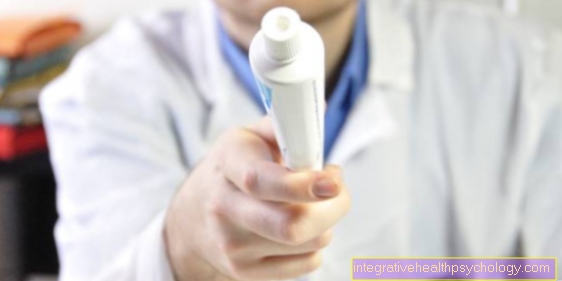

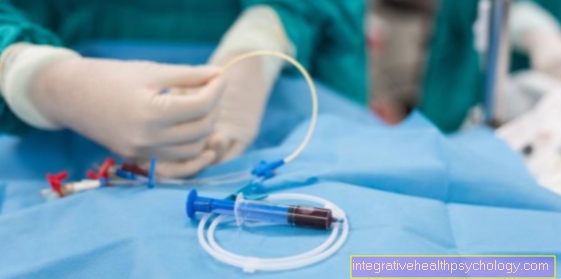
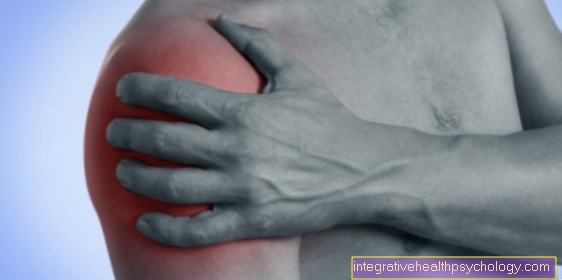



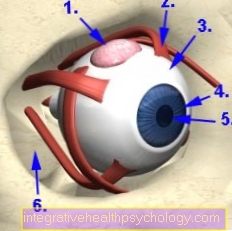
.jpg)


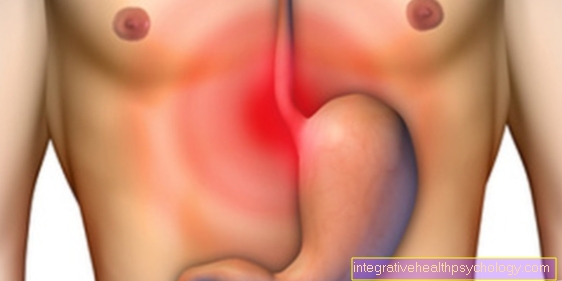


.jpg)






